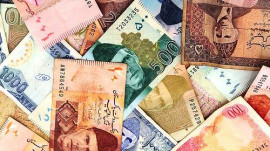
The Pakistani currency has maintained a freefall against the US dollar through the year of 2022, in the wake of political unrest and temporary suspensions of the International Monetary Fund (IMF) loan programme. The rupee pulled down by 22% in the year to Rs226.43 against the greenback in the interbank market on Friday.
The year 2023 is, however, projected itself to remain another bleak year for the domestic currency. Some local research houses have anticipated the currency dropping to somewhere between Rs250-270 against the greenback by June 30, 2023. Others, however, predict the rupee dropping to Rs265-270 by December 31, 2023, despite the IMF resuming its loan programme for Pakistan sometime in February 2023.
Speaking to the Express Tribune, Topline Securities Director Research Umair Naseer said, “The rupee’s actual value is the one at which the dollar is available in the black market; which is Rs250-260 against the greenback at present.”
The rupee-dollar exchange rate prevailing at the inter-bank market has become ineffective considering Finance Minister Ishaq Dar has partially controlled it. “This (controlled exchange-rate) has remained one of the biggest reasons behind the suspension of the IMF programme these days.”
AA Gold Commodities Director Adnan Agar, while speaking to The Express Tribune, warned that, “The rupee may depreciate to Rs280-300 or more in case Pakistan and the IMF fail to resume the programme soon.”
Pakistan, however, will manage to acquire the deal sooner or later as it has shown a willingness to implement the tough conditions agreed upon under the programme.
Naseer explained that, “The Russia-Ukraine war proved to be the worst event of the year, at a global level, impacting almost every country including Pakistan.”
The war spiked global commodity prices to a historical high, spiking inflation to a 40-year high in the world, forcing international banks to increase their interest rates. “This has made the task of raising new debt extremely expensive for countries like Pakistan, impacting its foreign exchange reserves,” he said.
The domestic front also did no favours to the currency. To recall, the rupee was standing at Rs177-178 before the Pakistan Tehreek-i-Insaaf (PTI) government was ousted through a vote-of-no-confidence in April 2022; since then, it hit an all-time high of Rs239.94 against the greenback in late July 2022.
The change of the government and provision of subsidies on local petroleum products, amounting to over Rs1 billion a month, was among the reasons then for the temporary suspension of the IMF programme, badly impacting the rupee through February. “The delay in implementing tough decisions by the then new Pakistan Muslim League-Nawaz (PML-N) coalition government, including the removal of a subsidy on petroleum products, kept the IMF programme suspended until the end of August 2022. This continued to impact the country’s foreign exchange reserves and the rupee-dollar parity,” Naseer said. “Controlling of the rupee-dollar parity in the inter-bank market is itself a big reason for the drop in the level inflows of US dollars through legal channels and the devaluation of the local currency,” he added.
The flow of remittances sent home by overseas Pakistanis through official channels hit a 27-month low at $2.10 billion in November 2022 – 14% lower than November 2021, mounting unnecessary pressure on the rupee.
Similarly, exporters are said to be using illegal hawala-hundi to receive part of their payments to get the maximum benefit of a high value dollar (Rs250-260) in the black market compared to the one (Rs227) in the inter-bank market.
A notable drop in total export earnings in the recent months has also been reported. This has also played a role in mounting pressure on the rupee against the US dollar.
The return of the Taliban government in Afghanistan also heavily impacted Pakistan’s foreign exchange reserves and rupee-dollar parity. Exchange Companies Association of Pakistan (ECAP) President Malik Bostan said, “Afghanistan has been sucking around $2 billion per month through smuggling US dollars and high-value commodities (including wheat and fertiliser) from Pakistan.”
“We will see a further weakening of the rupee in 2023,” predicted Naseer.
“Low foreign exchange reserves, a drop in export earnings, fewer workers’ remittances coming in, and a gradual reopening of imports will further widen the gap between demand and supply of the foreign currency and devalue the rupee,” he added.
With the foreign exchange reserves dropping from $20 billion some 16-month ago to the alarming level of $5.8 billion at present also forced the government to almost choke supply at the open market.
The situation then compelled businesses and households to park their savings into gold to escape the rapid devaluation. This gave gold the wings to fly to a historical high of around Rs183,900 per tola (11.66 grams).
“Gold has emerged as the top asset having offered the single largest return on investment so far in 2022,” said Topline Research. “Gold posted a gain of 41% in 2022, rising from Rs108,200 (per 10 gm) to Rs152,700 after gaining 11% in 2021. In the local, Sarafa/bullion market gold rallied in line with the increase in the US dollar rate in the black market. Currently, gold is valued at black market parity rather than the official rate which is 10% lower. Although in the international market gold remains more or less stable in 2022,” said the research house.
“After dollars disappearing from the open market, however, the local gold market is now also reporting a shortage of the precious commodity in the market suggesting its price may maintain a hovering high in the New Year 2023,” it said. All Pakistan Sarafa Gems and Jewellers Association’s (APSGJA) Member Abdually Abdul Razaq said, “Gold may even go up to Rs200,00 per tola in the coming months if the IMF programme remains derailed.”
“It is too difficult to give a full-year projection considering that gold is a global commodity and there is so much happening across the world. Over the next three months of 2023, however, the price of gold may maintain its current levels,” said the AA Gold Commodities director.
“Gold is all set to lose $100-150 per ounce to $1,650 to 1,700 over the next three months considering international banks may consider cutting their interest rates,” added Agar. On the other hand, he said, the expected depreciation in the rupee may also offset the drop of gold prices in the world markets.
Gold has extended the previous year’s outstanding rally on the first working day of 2023, jumping by a fresh Rs3,300 per tola (11.66 gram) to a new all-time high at Rs 187,200 on Monday. The pricing body has increased the rate despite the price remaining unchanged at $1,824 per ounce (31.10 grams) in the world markets; the domestic inter-bank currency market was closed on the day as well.
The gold market, however, uses the rupee value being quoted on the black market to calculate the bullion prices every day, suggesting the rupee has devalued even further in the illegal market. The currency was earlier available at Rs250-260 against the greenback. The new price of gold in Pakistan is Rs6,500 per tola more expensive than that available in Dubai, meaning the Pakistani bullion market has become more expensive than the international one. This should be a cause of concern for investors, as Pakistan stands as a relatively small market world around.
Published in The Express Tribune, January 3rd, 2023.
Like Business on Facebook, follow @TribuneBiz on Twitter to stay informed and join in the conversation.










1731570357-0/elon-musk-(1)1731570357-0-270x192.webp)
















COMMENTS (2)
Comments are moderated and generally will be posted if they are on-topic and not abusive.
For more information, please see our Comments FAQ